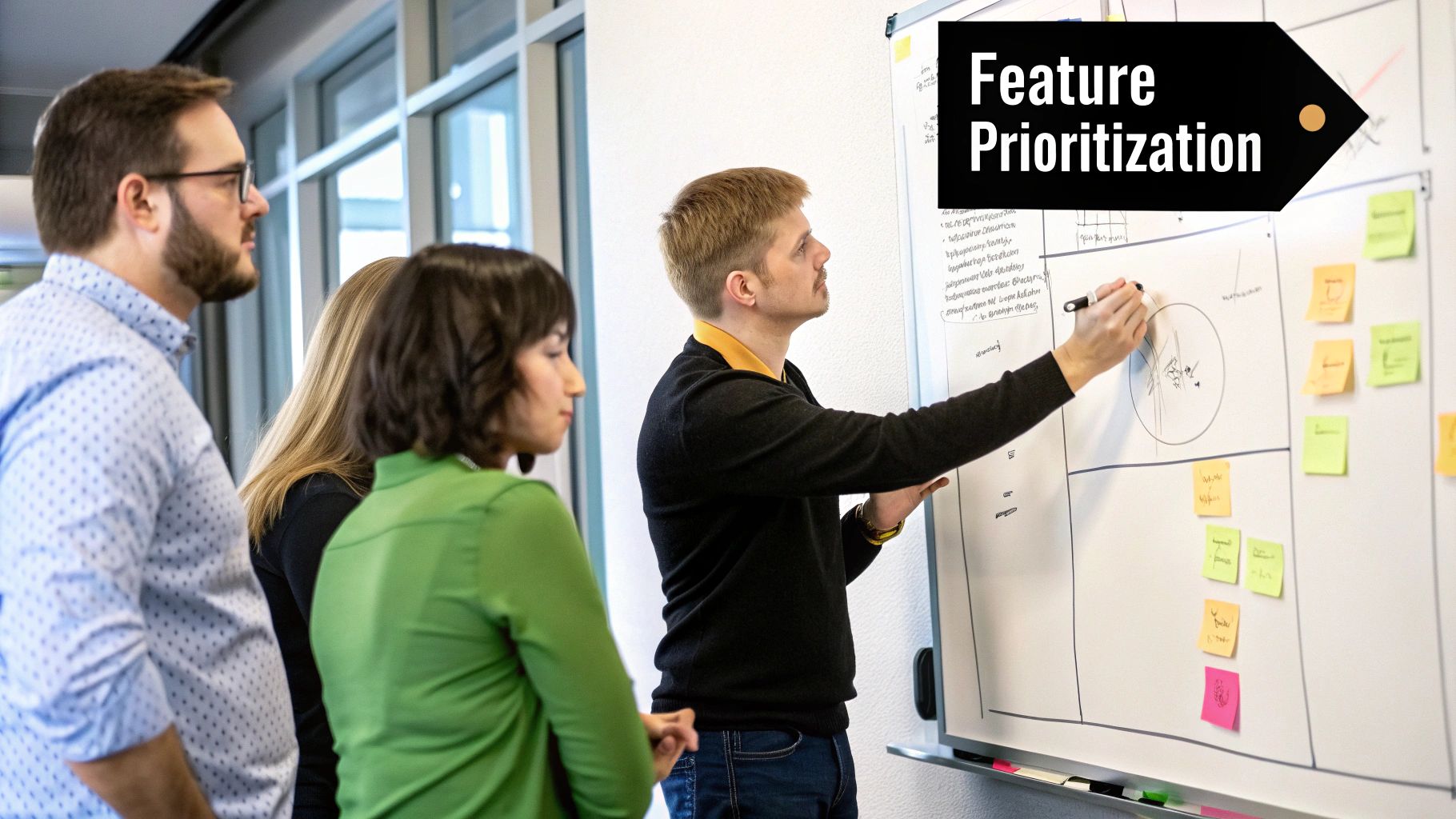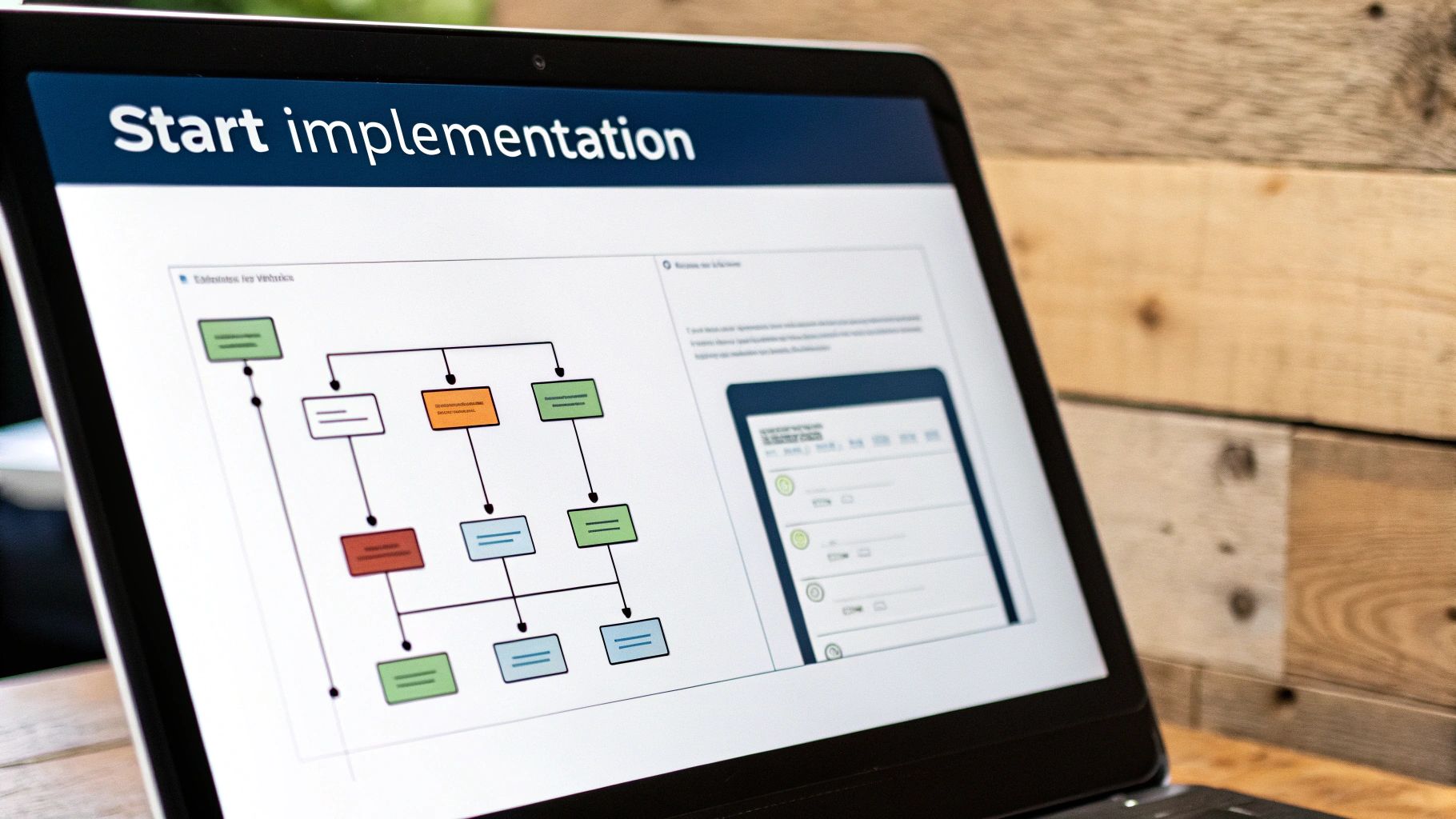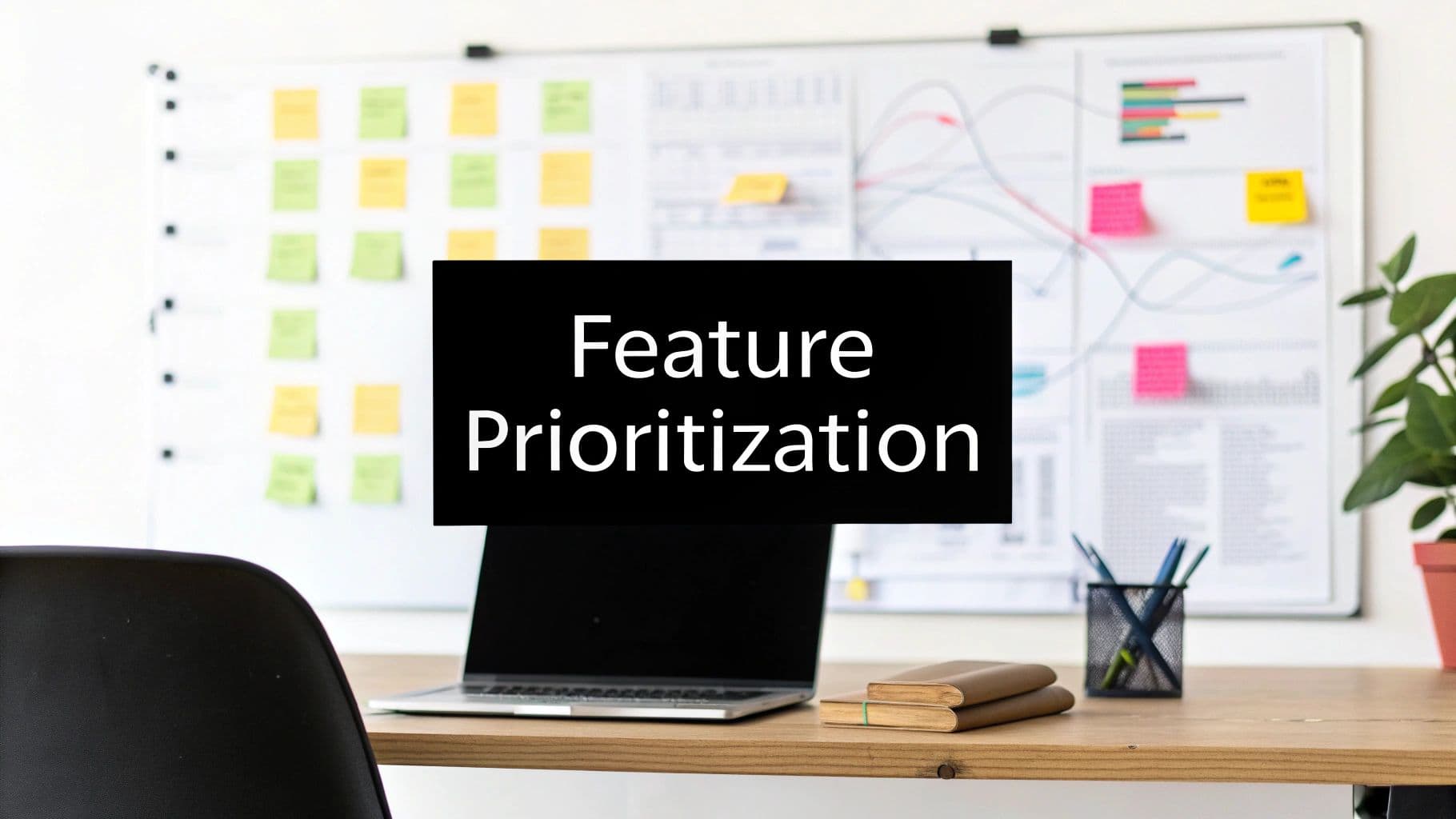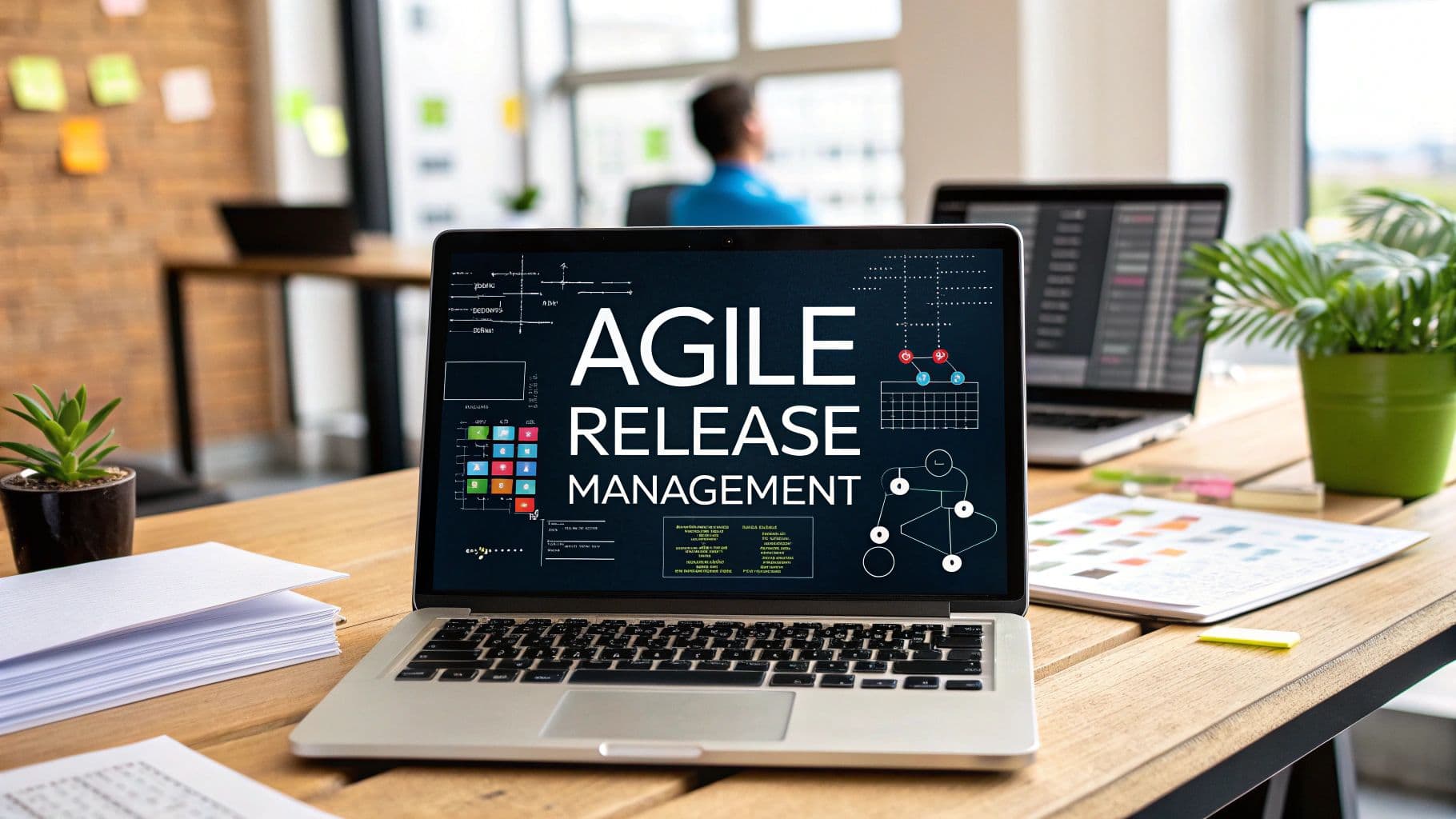feature prioritization framework
product management
RICE scoring
product roadmap
prioritization methods
Feature Prioritization Framework That Actually Works
When Feature Requests Feel Like Playing Whack-a-Mole

Imagine your Monday morning. Your inbox is overflowing with "urgent" feature requests. Sales needs that integration now – they promised it to a key client. Engineering wants to tackle that technical debt that’s been causing headaches. And your CEO just got back from a conference with a head full of new ideas. Sound familiar? This constant influx of requests can make you feel like you're playing whack-a-mole, leaving your team reactive and stressed. That's where a feature prioritization framework comes in.
The Real Cost of Reactive Prioritization
Prioritizing by gut feeling might seem quick in the moment. But like choosing the shortest checkout line only to get stuck behind someone with a coupon issue, it can backfire. Imagine spending a whole sprint on a feature a stakeholder really wanted, only to realize later it doesn't solve a real user need. That’s wasted development time, frustrated engineers, and a missed opportunity to build something truly valuable. Plus, reactive prioritization can make the team feel disconnected. Without a clear understanding of why certain features get priority, they can become demotivated.
From Chaos to Clarity: The Power of a Framework
A well-defined feature prioritization framework brings order to the chaos. Instead of relying on intuition or the loudest voice, it gives you a structured way to evaluate and rank features. Think of it as a recipe for success, ensuring you use the right ingredients in the right order. A project priority matrix template can help you visualize and manage these priorities. This leads to objective decisions based on agreed-upon criteria, creating transparency and team alignment. It lets you switch from reacting to requests to proactively planning for the future. By evaluating potential features against your strategic goals, you can anticipate needs and build a product roadmap that delivers real, lasting value.
Why Prioritization Is Your Secret Weapon
A feature prioritization framework is more than just organizing a backlog; it's a strategic advantage. It empowers teams to make smart choices aligned with business goals. This leads to greater efficiency, better products, and a more focused development process. Research shows that using a framework can reduce mis-prioritization by up to 18%. Discover more insights on feature prioritization frameworks. It transforms prioritization from a chore into a strategic tool, helping you build products that users love and that drive business growth. We'll explore what makes these frameworks effective and how to integrate them into your workflow in the next section.
What Makes Feature Prioritization Frameworks Actually Stick
Think of feature prioritization frameworks like a GPS for product decisions. They guide you toward your destination, but don't choose it for you. The frameworks that truly resonate share a few key elements: they transform heated debates into constructive conversations, promote transparency and trust, and unite teams around shared goals.
The DNA of a Successful Framework
Effective frameworks aren’t just about scoring systems; they're powerful communication tools. They get everyone on the same page, speaking the same language. They bridge the gap between the "urgent" feature requests from sales, the technical debt that keeps engineering up at night, and the CEO's "game-changing" ideas. To understand the challenges of feature requests and how to manage them, check out some client feedback form examples. These frameworks provide a structured way to evaluate requests based on shared criteria, not just who shouts the loudest.
A good framework brings order to the chaos, ensuring everyone's voice is heard and considered fairly.
Balancing Metrics and Human Insight
The best frameworks blend hard metrics with human understanding. They recognize that while data is vital, it doesn't tell the whole story. Customer needs, market trends, and strategic vision all play a crucial role in deciding what to build next. A purely data-driven approach can lead to features that look good on a spreadsheet but miss the mark with users.
On the flip side, relying solely on gut feeling can lead to wasted effort and missed opportunities. A successful framework helps you balance both, using data to inform decisions and intuition to grasp the nuances of user behavior.
Adaptability Is Key
No two organizations are identical, and a one-size-fits-all approach rarely works. Effective frameworks are flexible, allowing teams to adapt them to their unique situation. This might mean tweaking the weighting of certain criteria, incorporating qualitative feedback alongside quantitative data, or even combining elements from different frameworks.
This adaptability ensures the framework remains relevant and prevents it from becoming just another forgotten spreadsheet.
Real-World Examples of Framework Success
Companies like Intercom, with their RICE framework (Reach, Impact, Confidence, and Effort), and Apple, under Steve Jobs' leadership, highlight the power of effective prioritization. Intercom's RICE scoring provides a structured yet adaptable method for making feature decisions. Jobs' relentless focus on prioritizing a few key projects at Apple allowed them to create groundbreaking products like the iPhone and iPad.
These examples demonstrate that prioritization isn't about finding the "perfect" framework, but finding the right one for your team and adapting it to your needs.
The Frameworks That Product Teams Actually Use

The infographic above shows how common prioritization criteria, like value metrics, checklists, and user stories, fit into different frameworks. Think of it as a visual guide to organizing and weighing the different factors involved in deciding which features to build. A clear visual system is key for effective prioritization. Let's dive into some popular methods.
Weighted Scoring: The Flexible Foundation
One of the most popular methods is Weighted Scoring. It's adaptable, which is why it's a favorite among product teams at big tech companies. In fact, surveys show roughly 65% of these teams use it. Learn more about feature prioritization frameworks here. At its core, weighted scoring is a structured way to evaluate features based on set criteria.
Imagine building a messaging app. You might have criteria like "User Engagement," "Monetization Potential," and "Development Effort." Each gets a weight based on its importance. A feature's score is calculated by multiplying its rating in each category by the category's weight. This allows teams to tailor the process to their specific goals.
RICE Scoring: Balancing Reach and Effort
The RICE scoring model (Reach, Impact, Confidence, and Effort) adds a new layer of analysis. It asks teams to consider a feature's reach – how many users will it affect? Then, its impact – how much will it improve the user experience? Confidence scores acknowledge the uncertainty in estimations, while effort estimates keep things grounded in development realities.
Think of it like choosing a restaurant: you consider not only the food quality (impact) but also the distance (effort), how sure you are about the quality (confidence), and how many friends you can bring (reach).
Kano Model: Understanding Customer Delight
The Kano Model focuses on customer satisfaction. It divides features into: Must-haves, Performance Features, and Delighters. Must-haves are essential – their absence creates dissatisfaction. Performance features, like faster website loading, proportionally increase satisfaction. Delighters are unexpected bonuses, like a hidden feature in a game.
Think of a car. Brakes and a steering wheel are must-haves. Fuel efficiency is a performance feature. A sunroof? That's a delighter, adding an unexpected touch of luxury.
Impact/Effort Matrix: Visualizing Trade-offs
The Impact/Effort Matrix helps teams visualize the trade-offs between impact and effort. It’s great for communicating priorities to stakeholders, showing which features offer the best return and which should be delayed or dropped.
Imagine a garden. High-impact, low-effort features are like fast-growing vegetables. High-impact, high-effort features are like fruit trees – bigger investment, bigger payoff. Low-impact, high-effort features are weeds – best avoided. This simple framework is a great starting point for teams new to prioritization.
To further illustrate these different approaches, let's look at a comparison table:
Feature Prioritization Framework Comparison
A comprehensive comparison of the most popular prioritization frameworks, showing their strengths, ideal use cases, and complexity levels
| Framework | Best For | Complexity | Time Investment | Key Strengths |
|---|---|---|---|---|
| Weighted Scoring | Adapting to specific project needs | Medium | Medium | Flexible, customizable |
| RICE Scoring | Objective feature analysis | Medium | Medium | Considers reach, impact, confidence, and effort |
| Kano Model | Focusing on customer satisfaction | Low | Low | Categorizes features by their effect on satisfaction |
| Impact/Effort Matrix | Visualizing trade-offs and ROI | Low | Low | Simple, easy to understand |
This table highlights the key differences between these frameworks, showing how each offers a unique approach to prioritizing features. Choosing the right framework depends on your specific needs and project context.
RICE Scoring: Why This Framework Changed Everything
When Intercom introduced the RICE scoring model, they weren't simply adding another item to a product manager's to-do list. They were tackling a common problem: how to make feature decisions that everyone understands and agrees on. RICE’s strength comes from its simplicity and thoroughness. By breaking decisions down into Reach, Impact, Confidence, and Effort, it forces teams to consider all the important angles without getting lost in the weeds.
Understanding the Four Pillars of RICE
Let's explore each part of RICE. Reach measures how many users a feature will affect. Think of it like a ripple in a pond – a small pebble creates a smaller ripple than a large rock. Impact assesses how much the feature will improve the user experience and contribute to business goals. Is it a small tweak or a major improvement? This is where tying the feature to your overall product strategy is essential.
Confidence acknowledges that we don’t have a crystal ball. Are you 90% certain about your impact assessment, or is it more of a gut feeling? This honesty helps prevent teams from chasing features based on unrealistic expectations. Finally, Effort brings the process down to earth. How much development time will this feature really take? This balances the potential upside with the practical cost. There are various ways to approach this, as described in this helpful resource: Product Backlog Prioritization Techniques.
From Data to Decisions: Implementing RICE
RICE takes teams from gathering data to making concrete decisions. You begin by estimating reach, using your analytics or reasonable estimations. Next, quantify impact using a pre-defined scale that makes sense for your business objectives. Confidence scores are expressed as percentages, reflecting your level of certainty. Effort is often estimated in person-months, providing a realistic timeframe for development. Introduced by Intercom in the mid-2010s, the RICE scoring model is now utilized by roughly 40% of product teams at North American and European startups, as well as by several Fortune 500 companies. Discover more insights on the RICE scoring model.
Calculating the RICE Score
Once you have a value for each element, the RICE score is simple to calculate: (Reach * Impact * Confidence) / Effort. This gives you a single number that represents the overall priority of the feature. Imagine two features: one with high reach and impact but also high effort, and another with lower reach and impact but much lower effort. The RICE score helps you figure out which one offers the best bang for your buck.
To further illustrate this calculation, let’s look at some concrete examples. The following table breaks down how RICE scores are calculated for various features, using real numbers and scenarios.
RICE Scoring Calculation Examples
| Feature | Reach | Impact | Confidence | Effort | RICE Score |
|---|---|---|---|---|---|
| Onboarding Improvement | 5000 users | 3 (High) | 80% | 1 person-month | 12000 |
| New Search Filter | 2000 users | 2 (Medium) | 90% | 0.5 person-months | 7200 |
| Advanced Analytics Dashboard | 100 users | 1 (Low) | 50% | 2 person-months | 25 |
As you can see, even a feature with lower reach and impact can have a higher RICE score if the effort is significantly less.
Adapting RICE to Your Context
While the core ideas behind RICE remain the same, you can customize how you use it. You might tweak the impact scale, refine your effort estimations, or even include qualitative feedback along with the numbers. This adaptability is why RICE works so well across various teams and organizations. It’s not a rigid set of rules, but a flexible framework that can grow with your product and team. The real strength of RICE is its ability to foster informed discussions and build consensus. It allows teams to move beyond gut feelings and make data-driven decisions everyone can understand and get behind. This transparency builds trust and alignment, turning prioritization into a strategic advantage rather than a point of contention.
Advanced Strategies: When One Framework Isn't Enough

While individual feature prioritization frameworks provide helpful structure, seasoned product teams often find that relying on just one isn't enough. Think of it like a chef preparing a meal. They wouldn't just use a knife, right? They need a whole set of tools to create something truly special. In the same way, blending frameworks together creates a hybrid approach, capturing valuable insights that a single method might miss. This helps teams better address the complexities of user needs, market changes, and business objectives.
Combining Kano with Quantitative Frameworks
The Kano Model offers a unique perspective, showing the link between feature investment and customer satisfaction. It groups features into Must-haves, Performance Features, and Delighters, helping you grasp what truly matters to your users. However, Kano on its own lacks the hard data of frameworks like RICE. By combining Kano's qualitative insights with the quantitative scoring of RICE, product teams can make informed choices backed by data while also considering how features make users feel. For instance, a feature identified as a “Must-have” through Kano might get a higher weighting in the RICE scoring process.
This blend of "what users want" and "what we can deliver" helps create a balanced approach to product development.
The Impact/Effort Matrix: A Communication Powerhouse
The Impact/Effort Matrix isn’t just about prioritization; it’s a fantastic tool for communication. Its visual simplicity helps everyone across the organization understand the often-complex trade-offs involved. Imagine trying to explain a prioritization decision to a room full of stakeholders. Presenting a straightforward two-by-two matrix showing high-impact, low-effort opportunities versus high-effort, low-impact projects is much more effective than a spreadsheet packed with numbers. This visual clarity helps everyone get on the same page and understand the reasoning behind choices.
It turns a potentially dense discussion into an easy-to-grasp overview.
Avoiding Analysis Paralysis: The Power of Purposeful Blending
Using multiple frameworks doesn’t have to be overwhelming. Successful product teams choose and combine frameworks strategically, based on their specific circumstances. One common strategy is to use Kano for initial customer research, followed by RICE scoring for an initial ranking. Then, the Impact/Effort Matrix provides a concise summary for communication with executives. This streamlined approach uses the strengths of each framework without getting stuck in endless analysis. In 2022, a global survey of over 1,200 product managers found that 52% of teams use multiple prioritization frameworks, with the Kano Model and Impact/Effort Matrix among the most popular after Weighted Scoring and RICE. Discover more insights on feature prioritization frameworks here.
This data highlights the value of a multi-faceted approach to prioritization.
Building Your Custom System
The goal is to build a custom framework that works for your team and your company culture. This may involve tweaking existing frameworks, combining bits and pieces from various approaches, or even creating your own hybrid system. The objective is to build something that speeds up decision-making, not a complicated process that slows your team down. Remember, the ideal framework is the one that empowers your team to create products that users love and drive business success. By strategically blending frameworks, you create a strong system that captures both the quantitative and qualitative aspects of product development, ultimately leading to better choices and more effective products.
This allows you to tailor your approach to your specific context for maximum effectiveness.
Choosing Your Framework: A Practical Decision Guide
Selecting the right feature prioritization framework isn't about finding the "best" one. It's about finding the best fit for your team and your current situation. Think of it like choosing the right tool from your toolbox. A hammer is perfect for nails, but it won't help you much with screws. This section offers a practical guide to choosing a framework, starting with an honest look at your team, your available data, and your company culture.
Assessing Your Team’s Reality
First, consider your team’s capabilities. Are you a small startup moving at breakneck speed, or a larger, more established company? Early-stage startups often benefit from simpler frameworks like the Impact/Effort Matrix, which helps quickly visualize the trade-offs you’re making. It’s like using a simple map to navigate a small town – you get the information you need without being overwhelmed. Larger, more established companies, with more complex products, often need the more detailed analysis offered by RICE scoring or a Weighted Scoring system. This is akin to using a GPS with real-time traffic updates to navigate a busy city – you need more sophisticated tools for a more complex environment.
Next, think about the data you have available. Do you have detailed user analytics from tools like Google Analytics, or are you relying more on customer feedback and market research? If data is scarce, a framework like MoSCoW (Must have, Should have, Could have, Won’t have) might be a good starting point, allowing for qualitative prioritization based on stakeholder input. If you’re swimming in data, RICE scoring, which incorporates reach and confidence metrics, can be highly effective.
Your organizational culture also plays a role. How important is stakeholder buy-in? Frameworks like the Kano Model, which focuses on customer satisfaction, can be powerful tools for building consensus. Imagine presenting a feature prioritization plan based on what truly delights customers – it's a compelling argument that resonates across departments.
Key Questions to Guide Your Choice
To help navigate this decision, consider these key questions:
- Time Investment: How much time can your team realistically dedicate to prioritization? A complex framework in a fast-paced environment might end up unused.
- Data Access: What data do you have access to, and how reliable is it? This informs which metrics you can realistically track.
- Stakeholder Buy-in: How crucial is agreement on the decisions? Some frameworks are better at promoting transparency and collaboration.
- Team Dynamics: What working style does your team prefer? A collaborative team might thrive with Priority Poker, while a data-driven team might prefer RICE.
Templates and Checklists for Success
To avoid getting bogged down in analysis, use templates and checklists. These tools guide you through the process, making sure you consider all the relevant factors. A checklist might include questions like, “Do we have the data to accurately calculate RICE scores?” or “Does our company culture support a collaborative approach like Priority Poker?” These resources turn the selection process from a daunting task into manageable steps.
This approach helps you choose a framework that will become a valuable asset, not just another forgotten spreadsheet. By honestly evaluating your team’s context and needs, you can select a framework that will not only improve your product development process but also improve team communication and create better alignment. This proactive approach helps your team focus on delivering valuable features that delight users and drive business growth.
Making It Work: Implementation That Actually Sticks
The difference between a feature prioritization framework that truly helps your team and one that ends up forgotten comes down to implementation. Picking a framework isn't enough; you need to weave it into your team's workflow so it feels natural and easy to use. This section explores the people-focused side of adopting new ways to prioritize, highlighting strategies for lasting change.
Starting Small: The Power of Pilot Projects
Instead of launching a new framework across the entire company, begin with a pilot project. Select a single team or product area to test it out. This lets you smooth out any bumps and show its value before going bigger. It’s like trying out a new recipe before cooking for a crowd—you can adjust the ingredients and make sure everyone loves it before making a huge batch. This smaller-scale test reduces the chance of overwhelming the team and provides room for learning and adapting.
Communication Is Key: Building Stakeholder Confidence
Successfully introducing a new framework hinges on stakeholder communication. Explain the chosen framework and its advantages to executives, engineers, and customers in a way that builds confidence. For executives, show how it aligns with strategic goals and improves resource use. For engineers, emphasize how it leads to more focused work and reduces wasted effort. For customers, demonstrate how it delivers features they truly value. Clear communication prevents confusion and gets everyone on board.
Avoiding Common Pitfalls: Keeping It Real
Many implementations fail because of avoidable errors. One common mistake is over-complicating the process. A framework that's too complex can become a burden, hindering decision-making instead of helping it. Another issue is ignoring team dynamics. A framework that works for one team may not be right for another. Finally, failing to adapt the framework to your company's specific needs can lead to frustration and eventually abandonment. A successful implementation accounts for these factors and makes adjustments as needed. For example, the RICE model has proven effective across various organizational structures, leading to a jump in successful feature launches. It’s helped companies boost their success rate from 60% to over 80% by creating a more consistent, transparent, and data-driven process. Learn more about the RICE scoring model here. This demonstrates the positive impact of a well-implemented framework.
Iterating and Adapting: Embracing Continuous Improvement
Implementing a framework is not a one-and-done task. It's a continuous process. Regularly collect feedback from your team and stakeholders to find areas to improve. Be open to modifying the framework based on this input. This iterative approach ensures it stays relevant and useful. By focusing on constant improvement and adjusting to evolving needs, you can integrate the framework into your team’s core practices, leading to smarter product choices, better team alignment, and ultimately, a more successful product.
Fekri




